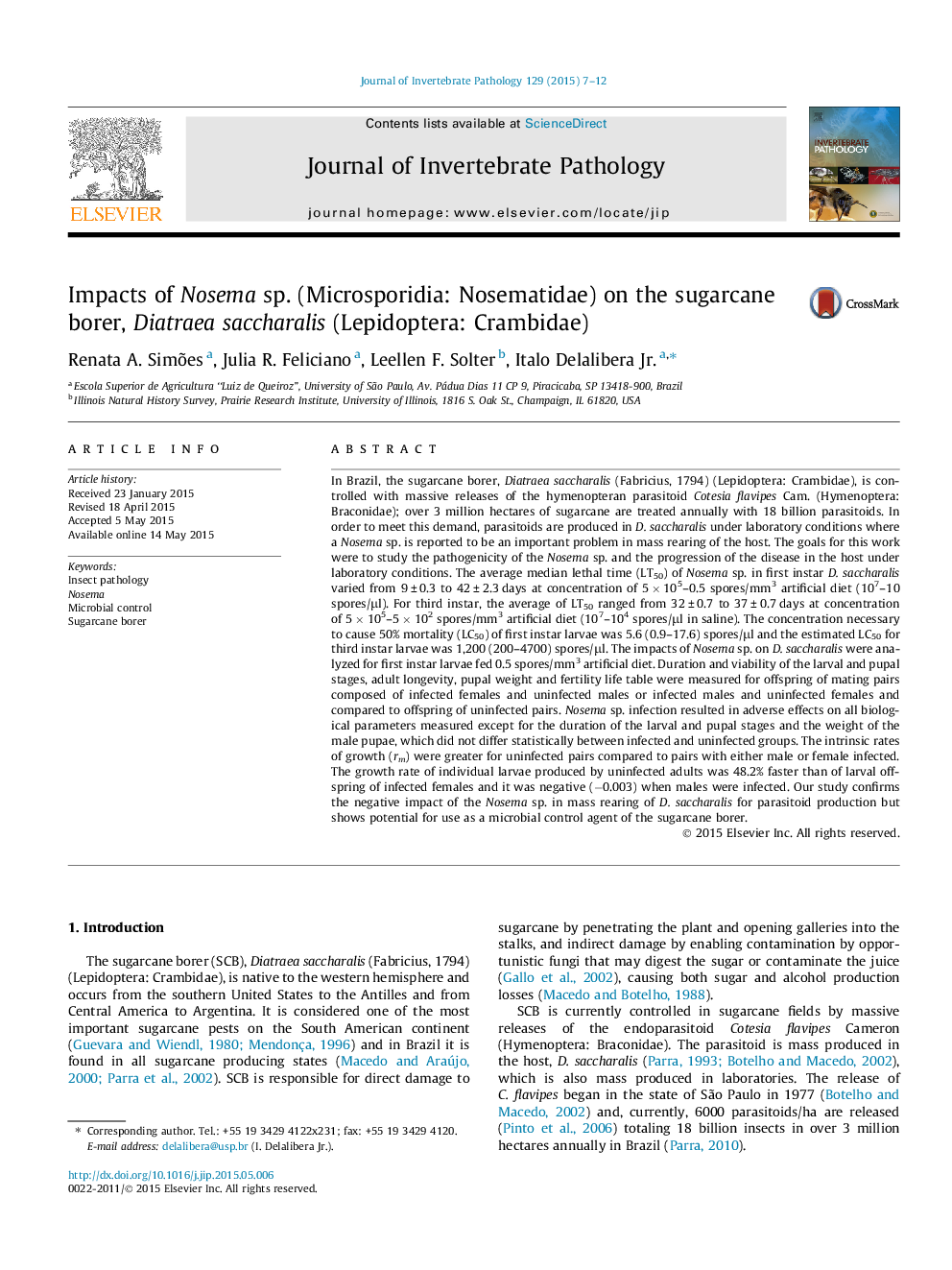| کد مقاله | کد نشریه | سال انتشار | مقاله انگلیسی | نسخه تمام متن |
|---|---|---|---|---|
| 6389464 | 1628223 | 2015 | 6 صفحه PDF | دانلود رایگان |

- Nosema sp. negatively impacted almost all biological parameters of D. saccharalis.
- The LC50 of neonate larvae is 221Ã lower than that of the third instar.
- Population growth from infected â and uninfected â was half the rate of the uninfected pairs.
- When uninfected â and infected â were paired, a decrease in population was observed.
- High density of Nosema sp. spores are produced in D. saccharalis tissues.
In Brazil, the sugarcane borer, Diatraea saccharalis (Fabricius, 1794) (Lepidoptera: Crambidae), is controlled with massive releases of the hymenopteran parasitoid Cotesia flavipes Cam. (Hymenoptera: Braconidae); over 3 million hectares of sugarcane are treated annually with 18 billion parasitoids. In order to meet this demand, parasitoids are produced in D. saccharalis under laboratory conditions where a Nosema sp. is reported to be an important problem in mass rearing of the host. The goals for this work were to study the pathogenicity of the Nosema sp. and the progression of the disease in the host under laboratory conditions. The average median lethal time (LT50) of Nosema sp. in first instar D. saccharalis varied from 9 ± 0.3 to 42 ± 2.3 days at concentration of 5 Ã 105-0.5 spores/mm3 artificial diet (107-10 spores/μl). For third instar, the average of LT50 ranged from 32 ± 0.7 to 37 ± 0.7 days at concentration of 5 Ã 105-5 Ã 102 spores/mm3 artificial diet (107-104 spores/μl in saline). The concentration necessary to cause 50% mortality (LC50) of first instar larvae was 5.6 (0.9-17.6) spores/μl and the estimated LC50 for third instar larvae was 1,200 (200-4700) spores/μl. The impacts of Nosema sp. on D. saccharalis were analyzed for first instar larvae fed 0.5 spores/mm3 artificial diet. Duration and viability of the larval and pupal stages, adult longevity, pupal weight and fertility life table were measured for offspring of mating pairs composed of infected females and uninfected males or infected males and uninfected females and compared to offspring of uninfected pairs. Nosema sp. infection resulted in adverse effects on all biological parameters measured except for the duration of the larval and pupal stages and the weight of the male pupae, which did not differ statistically between infected and uninfected groups. The intrinsic rates of growth (rm) were greater for uninfected pairs compared to pairs with either male or female infected. The growth rate of individual larvae produced by uninfected adults was 48.2% faster than of larval offspring of infected females and it was negative (â0.003) when males were infected. Our study confirms the negative impact of the Nosema sp. in mass rearing of D. saccharalis for parasitoid production but shows potential for use as a microbial control agent of the sugarcane borer.
Journal: Journal of Invertebrate Pathology - Volume 129, July 2015, Pages 7-12